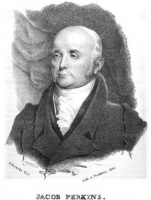










Jacob Perkins (9 July 1766 – 30 July 1849) was an American inventor, mechanical engineer and physicist. Born in Newburyport, Massachusetts, Perkins was apprenticed to a goldsmith. He soon made himself known with a variety of useful mechanical inventions and eventually had twenty-one American and nineteen English patents. He is known as the father of the refrigerator.[citation needed] He was elected a Fellow of the American Academy of Arts and Sciences in 1813.
Early life
Jacob went to school in Newburyport till he was 12 and then was apprenticed to a goldsmith in Newburyport named Davis. Mr. Davis died three years later and Jacob (only fifteen) continued the business of making gold beads and added the manufacture of shoe buckles. When he was twenty-one he was employed by the master of the Massachusetts mint to make a die for striking copper coins, this was the cent bearing an eagle and an Indian.
Family
Jacob married on Nov. 11, 1790 to Hannah Greenleaf of Newbury and they had nine children in his family. His second son, Angier March Perkins (1799–1881), also born at Newburyport, went to England in 1827, and was in partnership with his father (later taking over the business on the latter's death). His grandson, Loftus Perkins (1834–1891), most of whose life was spent in England, experimented with the application to steam engines of steam at very high pressures, constructing in 1880 a yacht, the Anthracite.
Invention
Jacob Perkins invented a method of plating shoe-buckles. Jacob Perkins invented a machine for cutting and heading nails in one operation (1795) and created improvements in bank-note engraving (steel) plates. Jacob Perkins invented the bathometer (measures the depth of water) and the pleometer (measures the speed at which a vessel moves through the water). Perkins also invented an early refrigerator (really an ether ice machine). Jacob Perkins improved steam engines (radiator for use with hot water central heating - 1830) and made improvements to guns.